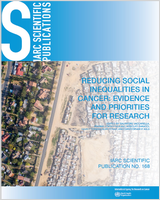From: Chapter 4, Measuring socioeconomic status and inequalities

NCBI Bookshelf. A service of the National Library of Medicine, National Institutes of Health.
| Indicator | Measurement and examples | Interpretation and comments |
|---|---|---|
| Income | Individual or household: monthly or annual; before taxes; equivalized (household income by household size) Government or state welfare benefit support; food stamps Absolute or relative poverty thresholds | Measures access to material resources (food, shelter, and culture) and access to services (health care, leisure or recreation activities, and education) Relates to social standing or prestige Reverse causality: health impacts on level of income Context-specific: country, sex, age |
| Education | Educational attainment: highest level attained; qualifications; years completed; ISCED | Reflects early-life SES, usually stable across the life-course Strong determinant of employment and income Influences position in society or social networks Affects access to health care or information Determines values, cognitive decision-making, risk taking, behaviours, and life skills Affects exposure to and ability to cope with stressors Reverse causality: childhood poor health impacts on school attendance and attainment Context-specific: country education system, age cohorts |
| Occupation | Employment or job history: longest, first, last; blue or white collar; manual or non-manual; “head of household”; RGSC; NS-SEC; European Socioeconomic Classification; American Census Classification; Wright’s Social Classification (Wright, 1997); Lombardi et al. Social Classification (Lombardi et al., 1988); Erikson and Goldthorpe Classification (Erikson and Goldthorpe, 1992); country-specific classifications; ISEI; SIOPS Unemployment experience (ever or number of years) Type of contract: salaried or hourly wage; part-time, full-time, or zero-hours; short- or long-term contract; job insecurity | Reflects social standing or prestige, working relations and conditions Strong determinant of income Based on educational attainment Influences social networks, work-based stress, autonomy or control Reflects occupational hazards, exposures, or demands Excludes some groups (e.g. retired people, unpaid home workers or “housewives”, students, some self-employed) Context-specific: country (level of industrialization or deindustrialization), age cohorts Unemployment has particular impacts on social exclusion and income, poverty, and access to health care Reverse causality: health impacts on (un)employment |
| Wealth | Assets (total or specific): land, property, livestock; housing tenure; ownership of car, refrigerator, television, etc.; DHS; FAS | Reflects material aspect of socioeconomic circumstances Relates to income Context-specific: country, rural or urban Reverse causality: health impacts ability to accumulate wealth |
| Housing | Housing quality or conditions: overcrowding (number of residents per number of rooms); dampness; housing type; water and sanitation | Direct impact: exposures for specific diseases Relates to material circumstances Context-specific: country development Reverse causality: health impacts on money available to spend on housing |
| Compositional | Combinations of SES metrics: education or income (study-specific); income and wealth (FAS); WAMI Historic indicators: Hollingshead index of social position; Duncan index; Nam–Powers socioeconomic status; Warner’s index of status characteristics | Attempts to capture multiple dimensions of SES; however, composite indicators perhaps mask specific relationships and mechanisms which individual SES measurements provide |
| Childhood SES | Parental SES: parental (father’s or mother’s) occupation; household income or conditions; child-related benefits (e.g. entitlement to free school meals) Educational attainment (end of childhood or early years) | Used in life-course SES analyses to capture childhood socioeconomic circumstances |
| Subjective SES | Self-identification, comparison, or satisfaction: self-identification as upper, middle, or lower class; comparison of income with others; satisfaction with income; MacArthur Scales of subjective social status | Individual’s perception of his or her socioeconomic standing Relates to objective indicators of SES Could be part of psychosocial pathway of health inequalities |
| Social capital | Social support, inclusion, or exclusion: more than 100 tools identified in recent systematic review (25 with validated psychometric elements; Cordier et al., 2017); CAMSIS | Commonly measures domains of connectedness, community participation, and citizenship; no single instrument measures all aspects within the three domains of social inclusion Hierarchical social interactions reflect social and material advantage; conversely, social exclusion from social and community life can result from economic deprivation and low SES |
CAMSIS, Cambridge Social Interaction and Stratification Scale; DHS, Demographic and Health Surveys Wealth Index; FAS, Family Affluence Scale; ISCED, International Standard Classification of Education; ISEI, International Socioeconomic Index; NS-SEC, National Statistics Socioeconomic Classification (UK); RGSC, Registrar General’s Social Classification (UK); SES, socioeconomic status; SIOPS, Treiman’s Standard International Occupational Prestige Scale; WAMI, water and sanitation, the selected approach to measuring household wealth (assets), maternal education, and income index.
From: Chapter 4, Measuring socioeconomic status and inequalities

NCBI Bookshelf. A service of the National Library of Medicine, National Institutes of Health.